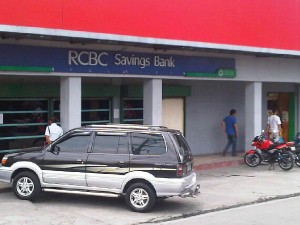PH banks seen weathering global crisis

Philippine banks are seen able to absorb potential loan losses arising from global economic uncertainties given their rising reserves, according to a Bangko Sentral ng Pilipinas report. INQUIRER.NET PHOTO/RICK ALBERTO
Universal and commercial banks in the country are seen able to absorb potential loan losses arising from global economic uncertainties given their rising reserves.
“The industry’s provisioning against potential credit losses remained adequate,” the Bangko Sentral ng Pilipinas said in a report.
Documents from the central bank showed that the average NPL coverage ratio of the universal and commercial banks in the country improved to 124.94 percent as of end-March from 120.37 percent in the same period last year.
The NPL [non-performing loans] coverage ratio is the proportion of soured loans to capital provisioning or “loan-loss reserves” for those loans. A loan becomes “non-performing” or “soured” if these remain unpaid at least 30 days upon maturity.
The BSP said the fact that the loan-loss reserves exceeded the bad debts showed that Philippine banks would remain stable even if a significant number of borrowers would default on their loans.
Amid the prolonged debt crisis in the eurozone, a key export market, economists said there was a likelihood earnings of export-oriented firms would remain anemic this year. They said this posed the risk of defaults by exporters on their obligations, including bank loans.
The BSP said, however, that in the case of the Philippines, banks were expected to withstand the adverse effects of a rise in loan defaults. It noted that an increase in loan defaults was even a remote scenario, citing that universal and commercial banks in the country generally adopt prudent lending standards.
The central bank earlier reported that the combined non-performing loans of universal and commercial banks in the country amounted to P74.65 billion as of end-March, while their combined outstanding loans reached P3.16 trillion. This resulted in an NPL ratio of 2.36 percent, down from 2.99 percent over the same period.
Non-performing assets (NPAs) of the banks amounted to P184.19 billion, while total assets reached P6.5 trillion as of end-March. NPAs are bad debts plus properties acquired from borrowers who defaulted on their loans. This resulted in an NPA ratio of 2.83 percent as of end-March, better than the 3.32 percent as of the same period last year.
With the favorable indicators, BSP Governor Amando Tetangco Jr. said the country’s banking system was generally sound and stable. Whatever drag the eurozone crisis might cause the Philippine banking sector was something that could be manageable, he said.














